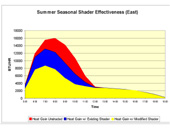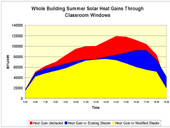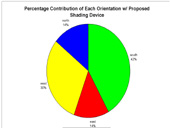

The redesigned sunshade consists of vertical fins at the depth of the existing horizontal projection that extend to the top of the window assembly. Early investigations of this design indicate that it is critical for the fins to provide shading to the currently unshaded daylight window for it to have any effect at reducing heat gains.
Providing vertical fins that shade the daylight window from direct sun significantly reduces the solar heat gain for these orientations. (see graphs) Gains for an individual bay are reduced by 28% from the existing condition, and 42% from the unshaded condition. Total building gains are reduced by 17% from the existing condition, and 33% from the unshaded condition.
These figures represent a reduction in the cooling load of 12,500 btu/hr, or approximately 1 ton of refrigeration capacity from the existing condition.

summer effectiveness, E. orientation

whole building gains in classrooms during summer

contributions for each orientation, new shade